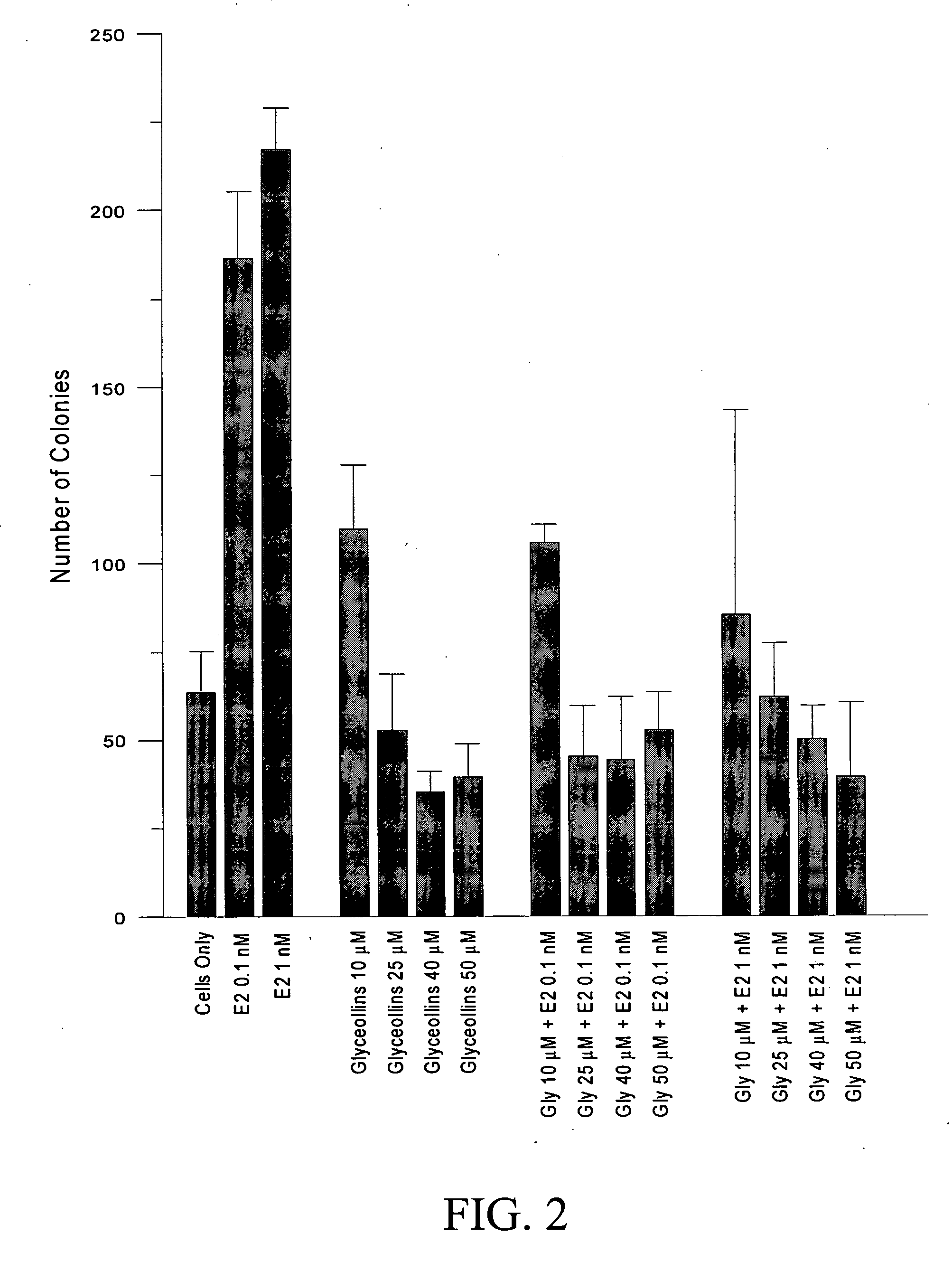Antiestrogenic glyceollins suppress human breast and ovarian carcinoma proliferation and tumorigenesis
- Summary
- Abstract
- Description
- Claims
- Application Information
AI Technical Summary
Benefits of technology
Problems solved by technology
Method used
Image
Examples
example 1
Soybean Treatment and Harvesting
[0038]Aspergillus sojae (S RRC 1125) cultures were grown at 25° C. in the dark on potato dextrose agar. After 5 days, inoculum was prepared by harvesting conidia (3.4×107 / ml) in 15 ml sterile, distilled H2O. Seeds from commercial soybean variety Asgrow 5902 were surface-sterilized for 3 min in 70% ethanol followed by a quick deionized-H2O rinse and two 2 min rinses in deionized-H2O. Seeds were presoaked in sterile deionized-H2O for 4-5 hr, then chopped for 2 min in a Cuisinart food processor. A. sojae spore suspension (300 μl) was applied to the cut surface of seeds on each tray. All trays were stored at 25° C. in the dark for three days, rinsed with water to remove spores, and oven dried at 40° C. for 24 hrs. Seeds were ground using a Waring blender before extraction.
example 2
Isolation of Glyceollins
[0039] A mixture of Glyceollins I, II, and III were isolated using a procedure developed at the Southern Regional Research Center (ARS, USDA, New Orleans, La.). Soybean seeds (1 kg) were sliced and inoculated with Aspergillus soiae, as in Example 1. After three days, the glyceollins were extracted from the inoculated seeds with methanol (1 liter). The Glyceollins were isolated using preparative scale HPLC using two Waters 25 mm 10 μm particle size μBondapak C18 radial compression column segments combined using an extension tube. HPLC was performed on a Waters 600E System Controller combined with a Waters UV-VIS 996 detector. Elution was carried out at a flow rate of 8.0 ml / min with the following solvent system: A+acetonitrile, B=water; 5% A for 10 min, then 5% A to 90% A in 60 min followed by holding at 90% A for 20 min. The injection volume was 20 ml. The fraction containing the glyceollins was concentrated under vacuum and freeze-dried. The glyceollins wer...
example 3
Cell Culture; In Vitro Colony Assay
[0040] The MCF-7N cell variant is a subclone of MCF-7 cells from the American Type Culture Collection (Manassas, Va.) that was generously provided by Louise Nutter (University of Minnesota, Minneapolis, Minn.) and has been previously described (Graham et al., supra). The BG-1 cell line has been previously described. MCF-7 and BG-1 cells were grown in Dulbecco's modified minimal medium (pH 7.4; Life Technologies, Inc., Grand Island, N.Y.) supplemented with 10% fetal bovine serum (Hyclone, Salt Lake City, Utah). For studies with estrogen, the cells were cultured in medium supplemented with 5% charcoal-stripped fetal bovine serum. The cells were incubated at 37° C. in an atmosphere of 5% CO2 and air.
[0041] MCF-7 cells are plated at 103 / well in 6 well Cluster dishes, and incubated overnight. Cells are cultured and treated in DMEM without phenol red; phenol red interacts with estrogen receptors. Treatment and control plates were incubated at 37° C., 5...
PUM
| Property | Measurement | Unit |
|---|---|---|
| Molar density | aaaaa | aaaaa |
| Molar density | aaaaa | aaaaa |
| Dimensionless property | aaaaa | aaaaa |
Abstract
Description
Claims
Application Information
 Login to View More
Login to View More - R&D
- Intellectual Property
- Life Sciences
- Materials
- Tech Scout
- Unparalleled Data Quality
- Higher Quality Content
- 60% Fewer Hallucinations
Browse by: Latest US Patents, China's latest patents, Technical Efficacy Thesaurus, Application Domain, Technology Topic, Popular Technical Reports.
© 2025 PatSnap. All rights reserved.Legal|Privacy policy|Modern Slavery Act Transparency Statement|Sitemap|About US| Contact US: help@patsnap.com



